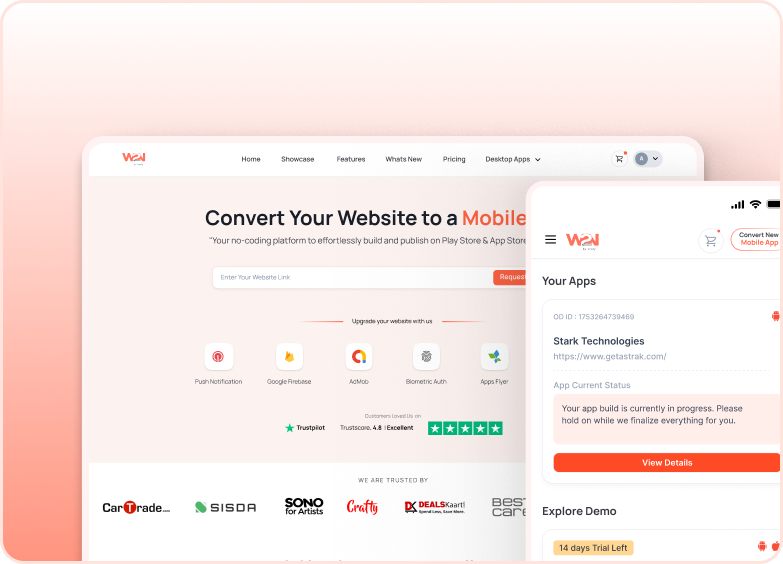Building a Scalable Mobile App for Business: WebToNative's Approach
Author:
Vanshika Choudhary
10 October, 2024
In the modern digital landscape, where mobile phones shape nearly every digital interaction, a static website no longer meets business goals. Rising customer expectations, combined with consistent growth in mobile activity, make scalability a root component of every successful mobile app development strategy. An architecture that enables your business to handle more users, add new features, and respond to evolving market conditions without increasing loading times or hindering user experience. WebToNative addresses this challenge by converting responsive websites into elegant mobile apps, empowering small and large businesses.
In this blog, we will outline the importance of scalable design, best practices for building scalable mobile apps, and describe how WebToNative contributes to the development of scalable mobile apps.

Why is scalability essential for Mobile Apps?
Scalability refers to a mobile app's ability to grow, whether due to increased user numbers, new features, or larger data sets, without slowing down or frustrating users—a genuinely scalable system has:
-
Serves pages to load quickly, even with high traffic
-
Acceptable new integrations or business requirements
-
Works smoothly when fresh services or third-party APIs are plugged in
-
Maintain the stability and security of the first user to a million at all stages
For many small and medium-sized businesses, scalability means the difference between progress beyond the original platform within a year and creating a digital solution that grows alongside the company.
Best Practices for Building a Scalable Mobile App
To help your mobile application expand alongside the business it supports, adopt several recognised scaling best practices.
1. Adopt a Modular Architecture
Design an app that can be divided into modules or components that developers can work on or upgrade independently. This way, it is easier to add new features or fix bugs without affecting the module, and leaves the rest of the system running.
2. Use Cloud-based Infrastructure
Host the code and data in cloud environments such as AWS, Firebase, or Azure that automatically allocate resources based on traffic needs. This enables your app to grow without manual server upgrades.
3. Optimise Performance
Introduce caching layers, lazy content-loading, and streamlined APIs so that screen transitions feel instant even under heavy load. Slow-loading mobile apps lose customers quickly, and that penalty becomes abrupt as user numbers rise.
4. Carry Cross-Platform Needs
Build mobile apps with cross-platform compatibility, such as Flutter or React Native, unless device-specific features demand otherwise. A single codebase reduces maintenance costs and ensures smooth performance on both Android and iOS.
5. Monitor, Measure, Adjust
Combine crash-logging, user analytics, and real-time performance dashboards to identify slow queries and broken features. Regular reviews enable the team to adjust scalability resources before user complaints increase.
6. Secure and Comply
The expansion of user data increases the potential for violations. Use strong encryption, schedule regular software updates, and follow data protection laws such as GDPR to safeguard information and boost users' trust while scaling operations.
How WebToNative is contributing to building scalable mobile apps?
WebToNative converts your website into a full-featured mobile app that scales with your growth. What distinguishes WebToNative is its commitment to delivering responsive builds that are engineered for future demands.
Here's a closer look at how WebToNative creates scalable applications:
1. Optimised Performance from Day One
WebToNative makes sure that the mobile app of your website is lightweight and lean, leading to negligible load times across modern devices. The result is a fast, fluid launch that holds up as daily active users climb.
2. Built on a Flexible Architecture
WebToNative supports a flexible architecture that is a modular setup, which enables smooth integration of new features like loyalty portals, chat interfaces, and marketplace plug-ins when your mobile apps are ready for these types of integrations.
3. Native-Like Experience
WebToNative powers native features such as push notifications, camera, media, and offline access to drive user engagement. These features play an important role in user retention rates as your app scales.
4. Cross-Platform Compatibility
A single codebase compiles to both iOS and Android bundles, so marketing can target wider segments without tripling timelines or budgets.
5. Effortless Updates and Maintenance
WebToNative enables changes to be made through your website's backend to make your app stay updated and bug-free without complex deployments that are important for long-term scalability.
6. Analytics
WebToNative-powered apps seamlessly integrate with analytics platforms such as Google Analytics and Firebase, enabling developers to monitor user behaviour and system performance in real time while guiding evidence-based decisions on feature improvements and performance tuning.
Conclusion
Developing a basic mobile application has become a relatively straightforward task. Creating an application that can grow in step with an expanding organisation, however, introduces a different and more complex set of concerns. Scalability ensures that the app will not merely endure periods of rising demand but will benefit from them. Performance, system architecture, adaptive design, and robust analytics are only a few of the elements that must be carefully integrated to achieve that goal.
Ready to transform your website into a scalable mobile app? Let WebToNative guide your journey to mobile success.
Similar Blogs




